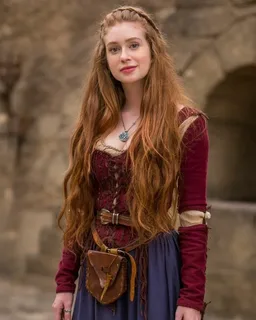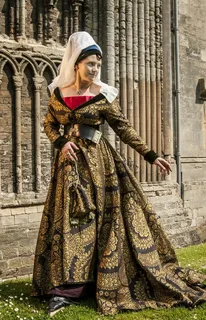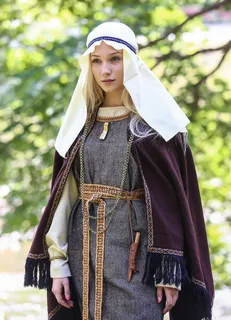Ever wondered what it was like to dress in medieval fashion for women?
The medieval period was a time of fascinating styles, vibrant colors, and intricate designs.
While many think of knights and castles when they hear “medieval,” women’s fashion during this time was just as rich and captivating.
This article dives deep into the styles, materials, and significance of medieval fashion for women, helping you appreciate the era’s influence on modern fashion.
What Is Medieval Fashion?

Medieval fashion refers to the styles and clothing worn in Europe during the Middle Ages, roughly from the 5th to the late 15th century.
The fashion was diverse and varied widely depending on the time period, region, and social class.
Women’s fashion, in particular, was characterized by layers, textures, and a keen sense of aesthetics.
Key Features of Medieval Fashion for Women
- Layering: Women often wore multiple layers of clothing.
- Fabrics: Common materials included wool, linen, and silk.
- Colors: Bright colors were popular among the wealthy, while muted tones were more common among peasants.
- Accessories: Belts, brooches, and veils were often used to enhance an outfit.
Evolution of Medieval Fashion for Women
Early Medieval Period (5th – 10th Century)
During the early medieval period, fashion was influenced heavily by Roman styles.
Women wore long tunics, often reaching the ground.
These tunics were typically belted at the waist and could be made from wool or linen.
Key elements of early medieval fashion:
- Tunic: The basic garment, often featuring wide sleeves.
- Stola: A long dress worn over the tunic, primarily by women of higher status.
- Mantle: A cloak that served both as a fashion piece and a means of warmth.
High Medieval Period (11th – 13th Century)
As we moved into the high medieval period, fashion became more elaborate.
The use of color flourished, and women’s dresses started to include more intricate designs.
Notable features included:
- Cotehardie: A fitted dress with long sleeves, popular among noblewomen.
- Surcoat: A loose-fitting outer garment, often worn over the cotehardie, which was ideal for layering.
- Hennin: A tall, pointed headdress that became a fashionable statement among noblewomen.
Late Medieval Period (14th – 15th Century)
The late medieval period saw a shift towards even more intricate styles and luxurious materials.
Women’s fashion during this time was marked by:
- Gowns: Fitted bodices with flowing skirts became the norm.
- Chaperon: A type of hood that was worn in various styles, often paired with gowns.
- Decorative elements: Embroidery, jewels, and other embellishments were popular.
Modern Influence of Medieval Fashion for Women
Today, medieval fashion for women continues to inspire designers and fashion enthusiasts alike.
From Renaissance fairs to modern-day runway shows, elements of medieval fashion can be seen everywhere.
How to Incorporate Medieval Fashion into Your Wardrobe

If you’re looking to channel a bit of medieval flair into your modern wardrobe, here are some ideas:
- Layering: Embrace the art of layering. Combine long tunics with fitted leggings or wide-leg trousers for a contemporary take.
- Fabric Choices: Opt for rich fabrics like velvet or brocade to add a touch of luxury.
- Accessories: Incorporate medieval-inspired accessories like statement brooches or embellished belts to elevate your outfit.
- Modern Silhouettes: Look for dresses that feature fitted bodices and flowing skirts, echoing the gowns of the medieval period.
FAQs About Medieval Fashion for Women
Q: What were common fabrics used in medieval clothing?
A: Wool, linen, and silk were the most common fabrics. The wealthier classes often wore silk and finer wool, while commoners wore more basic linens and coarse wool.
Q: Did women wear pants during the medieval period?
A: No, women typically wore dresses and skirts. However, in some cultures, women wore undergarments that resembled modern trousers.
Q: How did social status affect medieval fashion?
A: Yes, social status significantly influenced fashion. Wealthy women had access to finer materials, vibrant colors, and elaborate designs, while poorer women wore simpler, more practical clothing.
Q: What role did accessories play in medieval women’s fashion?
A: Accessories were vital for completing outfits. They added style, indicated social status, and served practical purposes (like keeping garments in place).
Final Thoughts on Medieval Fashion for Women
Medieval fashion for women is a rich tapestry woven with history, culture, and artistry.
Understanding the nuances of this era not only gives us insight into past styles but also inspires modern fashion.
So, the next time you see a flowing gown or a chic layered outfit, think of the medieval influences that shaped it.
Whether you’re dressing for a themed event or simply appreciating fashion, the elegance of medieval attire has a timeless allure.
If you’re intrigued by medieval fashion for women, consider exploring it further.
The blend of history and modernity can be a fun and expressive way to enhance your wardrobe!
Read more: womenfashionwear.site

